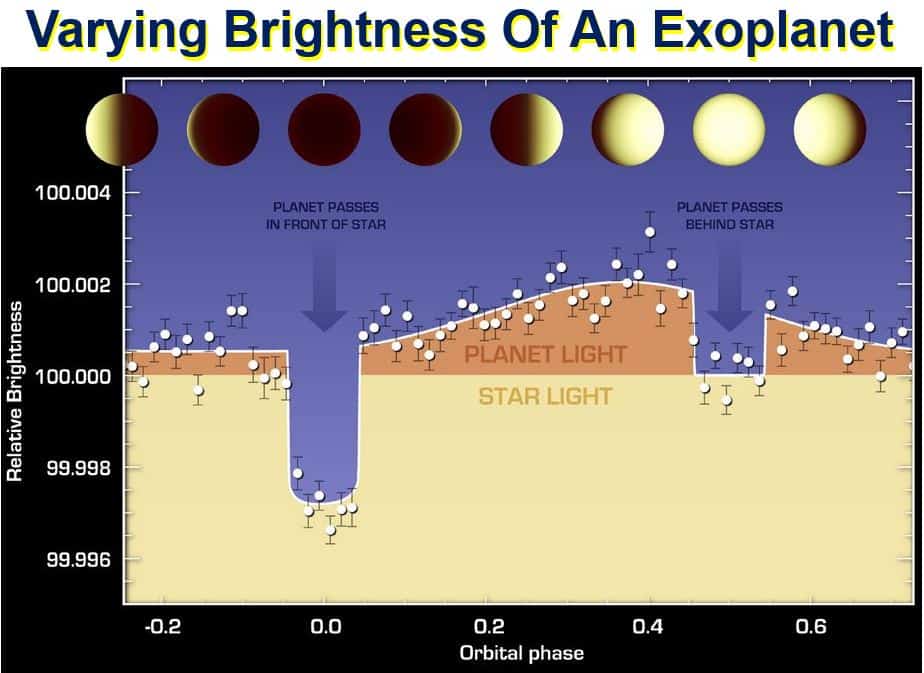Scientists have created the first temperature map of a super Earth planet called 55 Cancri e, which is an ultra-hot world with what appears to be an atmosphere in just one hemisphere. 55 Cancri e is almost twice the size of the Earth, and has extreme swings of temperature from one side to the other, which may be due to lava flows.
The temperature map was made after gathering and analyzing data from NASA’s Spitzer Space Telescope, formerly the Space Infrared Telescope Facility, an infrared space observatory that was launched in 2003.
A team of scientists from Belgium, Switzerland, the UK and USA wrote about their findings and achievement in the prestigious scientific journal Nature (citation below).
 An illustration showing one possible scenario for the hot, rocky exoplanet called 55 Cancri e, which is nearly twice as wide as Earth. (Image: jpl.nasa.gov)
An illustration showing one possible scenario for the hot, rocky exoplanet called 55 Cancri e, which is nearly twice as wide as Earth. (Image: jpl.nasa.gov)
55 Cancri e keeps evolving
Lead author, Dr. Brice-Olivier Demory, a research associate at Cambridge University’s Battcock Centre for Experimental Astrophysics, said regarding the team’s latest findings:
“Our view of this planet keeps evolving. The latest findings tell us the planet has hot nights and significantly hotter days.”
“This indicates the planet inefficiently transports heat around the planet. We propose this could be explained by an atmosphere that would exist only on the day side of the planet, or by lava flows at the planet surface.”
The ultra-hot super-Earth 55 Cancri e is just forty light-years away, which in the world of astronomy is quite near. It orbits very close to its parent star, completing one orbit every 18 hours.
 The varying brightness of an exoplanet called 55 Cancri e is shown in this plot of infrared data captured by NASA’s Spitzer Space Telescope. (Image: jpl.nasa.gov)
The varying brightness of an exoplanet called 55 Cancri e is shown in this plot of infrared data captured by NASA’s Spitzer Space Telescope. (Image: jpl.nasa.gov)
Exoplanet is tidally locked
Because it is so near to its star, it is tidally locked by gravity, i.e. the same side faces the star all the time, just as our Moon does with Earth.
This means that one side of this super-Earth is the perpetual day side, always cooking under the extreme heat of its star, while the other (night) side is much cooler and remains in the dark. ‘Cooler’ is a relative term – the cool side for us is extremely hot, far too hot for life as we know it to exist.
Dr. Demory said:
“Spitzer observed the phases of 55 Cancri e, similar to the phases of the moon as seen from the Earth. We were able to observe the first, last quarters, new and full phases of this small exoplanet.”
“In return, these observations helped us build a map of the planet. This map informs us which regions are hot on the planet.”
The Spitzer Space Telescope stared at 55 Cancri e for a total of 80 hours, watching it complete several orbits. Its data allowed the researchers to map the temperature changes across the whole planet.
 An animated illustration showing one possible scenario for the rocky exoplanet, with one side much hotter than the other. This could be explained by a possible presence of lava pools. (Animation: jpl.nasa.gov)
An animated illustration showing one possible scenario for the rocky exoplanet, with one side much hotter than the other. This could be explained by a possible presence of lava pools. (Animation: jpl.nasa.gov)
Huge difference in temperature
They were surprised to find a dramatic temperature difference between one side of the planet and the other – a difference of 1,300 Kelvin (2,340 °F). Its hottest side is almost 2,700 Kelvin (4,400 °F), while its ‘cooler’ side is 1,500 Kelvin (2060 °F).
Such a massive difference in temperature between the two sides of the planet means it is not distributing heat very well. This data challenges previous suggestions by scientists that a thick atmosphere and strong winds were moving heat around the planet.
The findings now suggest that there is no massive atmosphere on this planet. It is probably a lava world where the lava becomes hardened on the cooler side, and unable to transport heat.
Dr. Michael Gillon, an astrophysicists at the University of Liège in Belgium, said:
“The day side could possibly have rivers of lava and big pools of extremely hot magma, but we think the night side would have solidified lava flows like those found in Hawaii.”
Planets hottest spot not where expected
Data gathered from Spitzer showed that the hottest spot on 55 Cancri e has shifted over slightly from where it was expected to be – directly under its blazing star. This shift suggests that either there is some degree of heat recirculation confined to the hotter side, or the presence of lava flows.
Future observations, including from NASA’s James Webb Space Telescope, should help confirm 55 Cancri e’s true nature.
Spitzer’s increased sensitivity to exoplanets (planets outside our Solar System) means its observations of 55 Cancri e are much more detailed. Over the past few years, engineers and scientists have devised new ways to improve Spitzer’s ability to measure changes in the brightness of exoplanet systems.
One way to get more detailed observations involves precisely characterizing the telescope’s detectors, specifically measuring ‘the sweet spot’ – a single pixel on the detector – which was determined to be optimal when studying exoplanets.
Jessica Krick, from NASA’s Spitzer Space Science Center, at the California Institute of Technology in Pasadena, California, said:
“By understanding the characteristics of the instrument — and using novel calibration techniques of a small region of a single pixel — we are attempting to eke out every bit of science possible from a detector that was not designed for this type of high-precision observation.”
Citation: “A map of the large day–night temperature gradient of a super-Earth exoplanet,” Tiffany Kataria, Nikole Lewis, Brice-Olivier Demory, Michael Gillon, Nikku Madhusudhan, Emeline Bolmont, Kevin Heng, Julien de Wit, Renyu Hu, Jessica Krick, Vlada Stamenković, Björn Benneke, Stephen Kane & Didier Queloz. Nature. 30 March 2016. DOI: 10.1038/nature17169.
Video – Transit of 55 Cancri e
